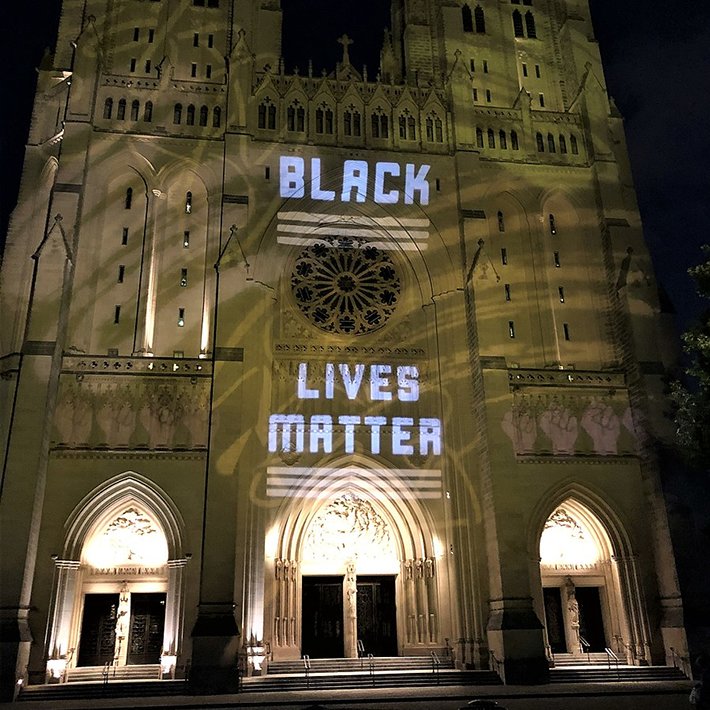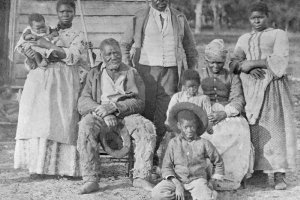Artist Kerry James Marshall wasn’t looking for publicity or money when he accepted Washington National Cathedral’s commission to replace stained glass windows glorifying the Confederate cause.

Instead, he charged $18.65, a figure representing 1865, the year America’s last enslaved human beings were set free.
“It’s a full payment that I can accept as a completely free individual, able to make decisions about myself and the things I do and who I do it for,” said Marshall, whose works have sold for millions. “I’m completely free. And that’s what the end of the Civil War represents on a lot of levels.”
The windows, which had honored Confederate generals Stonewall Jackson and Robert E. Lee, were originally donated to the Cathedral by the Daughters of the American Revolution in 1953. But times have changed and the cathedral removed them after the white supremacist “Unite the Right” 2017 rally in Charlottesville showed the fruits of bigotry: a car rammed deliberately into a knot of counter-protestors, leaving 35 injured and one dead.
“Simply put, these windows were offensive,” the cathedral’s Dean, The Very Rev. Randolph Hollerith, said. “They were intended to elevate the Confederacy, and they completely ignored the millions of Black Americans who have fought so hard and struggled so long to claim their birthright as equal citizens.” The new windows, he said, tell a different narrative, one “that lifts up the values of justice and fairness and the ongoing struggle for equality among all God’s children.”
The National Cathedral leaders charged Marshall to “capture both darkness and light, both the pain of yesterday and the promise of tomorrow, as well as the quiet and exemplary dignity of the African American struggle for justice and equality” and its impact on the nation.
Kerry Marshall responded to the call with four panels, titled “Now and Forever,” with images of Black Americans marching with handmade signs, the shapes and varying tones of color conveying passion and triumph as a continuing activity. The panels can be seen on the cathedral’s website.
“You have to strive for justice. It’s not something that is just there,” Marshall said. “It just seemed to me that if I was going to have the windows really embody the concept, they had to really address the activity.”
Gwendolyn DuBois Shaw, an art historian at the University of Pennsylvania who served on the cathedral’s window-replacement committee, said that Marshall, as one of the nation’s most prominent African American artists, was an obvious choice to reimagine the new windows. The committee wanted the new images to feel eternal and speak to a broad audience in communicating the Black cultural legacy.
“I really felt that he would be an artist who wouldn’t see this as an opportunity to increase the prices of his work or to showboat his aesthetic and artistic abilities in a way that was self-celebratory,” she said, “but rather that he would understand the deep meaning of this commission of something that would endure for a thousand years or more, provided he got it right.”
The two new stainedglass windows, created from sketches submitted to church leaders, were unveiled at the September 23 service. In attendance were prominent African Americans, including Supreme Court Justice Ketanji Brown Jackson, who gave readings as part of the service. Jackson read an excerpt from the Rev. Martin Luther King Jr.’s “Letter from Birmingham Jail.”
Marshall also spoke: “The cathedral stands for what the nation stands for and what I hope we all as members of this culture and society will embody and stand for and bring forward ourselves.”
In contrast to collaborations with other artists where several design submissions had to be submitted numerous times with alterations, the church accepted Marshall’s concept without a single change.
The design communicates the objective of fairness for all, Marshall explained—something everyone can agree with. “The windows have to speak for themselves in some way,” he said. “They have to not require a curatorial explanation in order for people to understand what they seem to be wanting to do.”
And although Marshall regards the image as secular—portraying everyday people demanding justice—Dean Hollerith disagrees, feeling that the work depicts humanity striving to turn the divine desire for universal freedom into a reality.
“There doesn’t need to be a cross in there anywhere, as far as I’m concerned,” said Hollerith, who has overseen the window replacement project. “The theme itself is, I think, very religious.”
The Washington National Cathedral has been hosting racial justice-themed forums concurrent with the window replacement project. Congregants attended public discussions regarding the narratives of the Confederate-themed windows, and how the iconography we cherish and glorify reflects where we are as a people.
The windows, after all, were present in the church when Dr. Martin Luther King, Jr. preached a Sunday sermon there on March 31, 1968. It would be his last. He was shot to death four days later.
_______________
From its beginnings, the Church of Scientology has recognized that freedom of religion is a fundamental human right. In a world where conflicts are often traceable to intolerance of others’ religious beliefs and practices, the Church has, for more than 50 years, made the preservation of religious liberty an overriding concern.
The Church publishes this blog to help create a better understanding of the freedom of religion and belief and provide news on religious freedom and issues affecting this freedom around the world.
The Founder of the Scientology religion is L. Ron Hubbard and Mr. David Miscavige is the religion’s ecclesiastical leader.
For more information, visit the Scientology website or Scientology Network.


